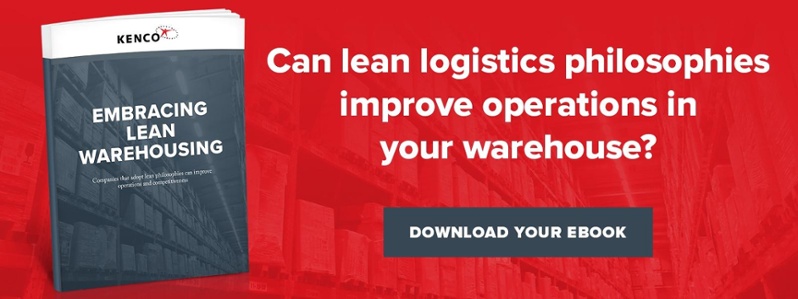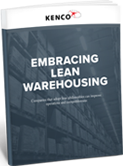
Improving warehouse operations is a complex undertaking involving the blend of physical space, equipment, placement, people, and processes. It’s not unlike throwing a dance party: you need the ideal size ballroom, tables correctly placed in relationship to the dance floor, the right band, people who know the dances and move well together, and great food and drink — all working together in concert.
What’s important to remember is there is not one right answer for optimizing warehouse operations. What is best for one company, one warehouse — even one product within a warehouse — is not necessarily best for another.
These 10 warehouse best practices can help you discover the best configuration for your warehouse, identify problem areas, and effectively solve them through the use of lean six sigma philosophies.
1. Know your profile.
You need to understand the mix of products coming in and out of your building: the number of pallets, the product mix, etc. As your profile changes your labor requirements, processes, and systems change as well. A manager who doesn't know his profile doesn't know his business.
2. Standardize your processes.
All major repetitive activities need standardized processes so they are consistently repeatable. Most importantly, repeatable processes allow work standards to be created and labor management and planning to occur. Without standard processes, Quality and Safety cannot sustain any improvement. Additionally, standard work allows visitors to the process to see when standards are not being met and then they can ask the "right" questions to allow kaizen to occur. As the old lean saying goes, you cannot measure what is not standardized.
3. Incorporate leader standard work (LSW).
The problem is traditional management practices don't create the cultural shift to daily problem solving needed to sustain and advance operational improvements. To make the shift, you, as a leader, must change what you do, but not haphazardly or impulsively. Just as operators have standardized work for their value-adding activities, you need predictable and repeatable standard activities that build people's problem solving capability moving them closer to daily continuous improvement.
Leader standard work enables coaching to occur, which allows associates to develop critical thinking skills which can then be applied to solve problems in the work area. These activities constitute a management practice known as Leader Standard Work.
4. Measure your processes.
Develop adequate baseline measurements for each process creating benchmarks to measure against as you improve your processes. Remember, you cannot improve what you do not measure.
Many leaders rush to improve before first developing a deep understanding of the current condition or measures of the process.
To effectively solve a problem, leaders must first understand the current condition. This can only be accomplished through the use of data and facts.
5. Go see for yourself.
 Leaders should visit the gemba often to witness for themselves the current state of the operation. Many times, leaders use opinion and feelings to make important decisions. Worse, they make many decisions sitting behind a desk looking at a computer screen or a long spreadsheet. The leader should always listen to people within their organization, but then go see for themselves. Not only does this clarify the situation, but it gives the leader a chance to interact with the process and people. This type of interaction is invaluable to an organization. If a leaders states he/she doesn't have time to visit the gemba, then they should reevaluate their priorities. If people are indeed our greatest asset, shouldn't we be spending most of our time with them developing their capabilities?
Leaders should visit the gemba often to witness for themselves the current state of the operation. Many times, leaders use opinion and feelings to make important decisions. Worse, they make many decisions sitting behind a desk looking at a computer screen or a long spreadsheet. The leader should always listen to people within their organization, but then go see for themselves. Not only does this clarify the situation, but it gives the leader a chance to interact with the process and people. This type of interaction is invaluable to an organization. If a leaders states he/she doesn't have time to visit the gemba, then they should reevaluate their priorities. If people are indeed our greatest asset, shouldn't we be spending most of our time with them developing their capabilities?
6. Incorporate a balanced scorecard approach.
You need to have measures for productivity, cost, quality, service, morale, and safety. You want to balance your operational scorecard; so if you improve one measure it doesn't come at the expense of another. These are the vital signs of your operation and understanding them is of high importance to the leader. An organization that has 15-20 or more "key" measures lacks clarity and focus. Reexamine your scorecard and make sure you are measuring the vital few.
7. Improve your processes.
Once you have standard, repeatable processes in place — as well as baseline measurements for all your processes — you need to continuously evaluate and improve them to be competitive in the marketplace. Your competition isn't resting on its laurels; you can’t either. Always strive to improve your processes, whether it is through incremental or transformational change. As the adage goes, the definition of insanity is doing the same thing over and over again, but expecting a different outcome.
8. Go from being reactive to proactive to predictive.
Your scorecard looks great, everything is in the green today, but six months in the future you may be heading for a cliff. Use quantitative analytics and trend analysis to predict where you’re going so you can avoid problems before they even occur. An operation that is able to predict performance based on business conditions has a competitive advantage in the marketplace.
9. Recruit and hire the right talent.
Not all talent is the same and not all industries need the same talent. Companies often create one profile for a position and use it for all industry verticals. Develop specific profiles, for specific roles, in each industry vertical (e.g. consumer goods, healthcare, food) and review those profiles regularly — especially as the market changes.
10. Correctly position the talent you already have.
You have very talented people, but you may not have them positioned so they can contribute the most to your operations. Following the Gallup StrengthFinder 2.0 process to best determine your optimal personnel placement: create talent grids, align them to developed profiles, and position your people accordingly. This will not only make your operations more efficient, but your people will be more successful, which elevates morale. Jim Collins stated this perfectly in his book Good to Great, "You must not only get the right people on the bus, they must be seated in the right seat on the bus".
Here's a bonus tip:
11. Slot and zone your warehouse efficiently.
Each item in a warehouse has its own unique combination of characteristics: how often it’s physically touched and in what combination with other items. You need to ensure products are optimally located to maximize operational effectiveness. Poor zoning or slotting leads to increased travel distance and touches, which always leads to higher operational costs.
Always focus on reducing the three deadly sins of a warehouse: travel distance, touches, and paper.
Do people have to travel great distances to pick orders or have you optimized the flow of the warehouse? Are you touching pallets multiple times or have you optimized for minimum touches? Have you minimized the amount of paper used because the more paper you touch, the more paper you have, and the more expensive the product. Reducing the three deadly sins will make your company more competitive in the marketplace.
To Sum It Up
As leaders, we should always be looking to the future and how we can do things better tomorrow than we are doing them today. With the limited resources everyone must live with, it is extremely important to have a process to prioritize opportunities and then have discipline to stay the course before new projects are started.
Remember, there are a lot of "things" we could do, even less "things" we should do, but only one "thing" we must do today to keep the business heading in the right direction. Having too many priorities creates a lack of focus and clarity in the organization which wastes resources and lowers organizational morale. Using the above 10 warehouse best practices will help you identify the greatest opportunities within your organization, continuously improve and stay competitive in the market place.
If you're ready to take the next step with your warehouse practices, it's time to implement lean warehousing. Our eBook below lays out the specific strategies you can employ next to make your warehouses more efficient, reduce costs, and smooth out your operations.





